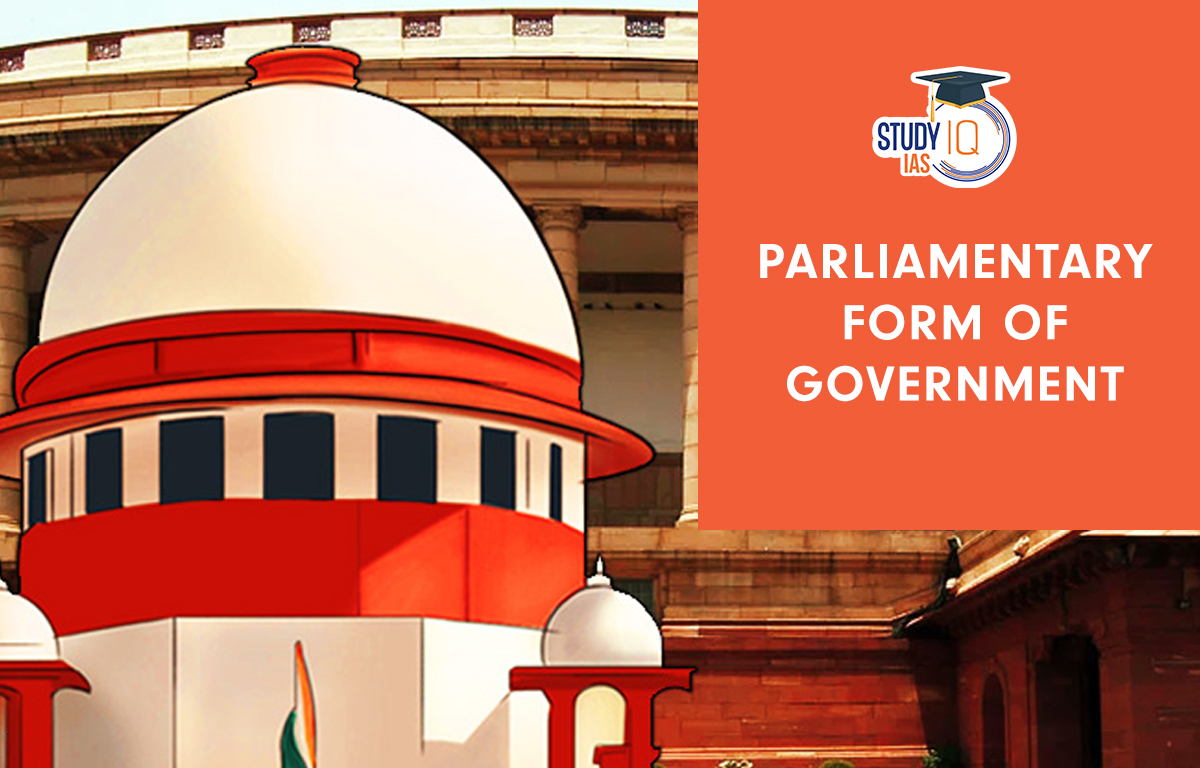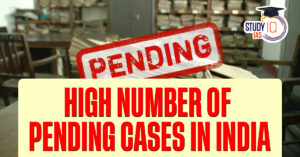Table of Contents
Parliamentary Form of Government
A democratic government known as a parliamentary one is one in which the political party winning the most seats in the federal election’s legislative or Parliament becomes the ruling party. India’s parliamentary system of government is comparable to that of the UK. A parliamentary form of government is one in which the executive and legislative branches have divided authority and are essentially inaccessible to one another. The Parliament is a better idea as a result. This article explains the Parliamentary government, its characteristics, merit and demerit are important for UPSC Syllabus. The UPSC Mock Test can help candidates prepare for the exam with more precision.
| Indian Parliamentary system: |
The Indian Parliamentary system is inspired by the UK and is often referred to as the cabinet or ministerial system. In this system, the executive and legislature work closely together, making Parliament very important.
|
Parliamentary Form of Government History
Since ancient times, councils or headmen, whose decisions were judged by village elders, have existed in tribal societies. These councils eventually evolved into the modern parliamentary system. In 1188, King Alfonso IX of León (Spain) convened the Cortes of León, which is considered one of the first parliaments in Europe. An early form of parliamentary government arose in the Netherlands and Belgium during the Dutch Revolt (1581) when the States-General took power from King Philip II of Spain. The modern parliamentary system took shape in the UK between 1707 and 1800, and in Sweden between 1721 and 1772. After World War I, democracy and parliamentary systems gained popularity across Europe.
Adoption in the Constitution
- Parliamentary System: India adopted a parliamentary form of government from Britain after extensive discussions.
- Constituent Assembly Debates: During the debates, various models were considered, including Presidential and Parliamentary systems. The parliamentary model was favored for its ability to provide strong leadership and accountability to the elected House.
Opinions:
- Professor K T Shah noted that parliamentary government connects the Executive, Legislative, and Judiciary.
- Shri K Hanumanthaiya argued that the parliamentary system is better suited to India’s needs than a Presidential system.
Also Read: Uniform Civil Code
Parliamentary Form of Government Features
There are some significant features of a Parliamentary Form of Government. They have been listed down below:
Real and Nominal Executives
The President serves as the formal executive, while the Prime Minister is the actual executive (de facto executive). As a result, the President is the President of the State, and the Prime Minister is the Prime Minister of the Government.
Dual Membership
The Prime Minister and the Council of Ministers represent the executive, while the Parliament serves as the legislative body. The executive is developed from the legislative since members of parliament elect the prime minister and other cabinet officials.
Collective Responsibility
The legislative branch holds the executive jointly responsible. There is a concept of collective accountability, meaning that the Council as a whole is accountable for the duties of each minister.
Secret Procedure
This type of management mandates that cabinet discussions be held in private and not made public.
Leadership under the Prime Minister
The Prime Minister is in charge of this kind of government.
Majority Party Rule
The prime minister is normally chosen by the leader of the party that gains a majority in the lower chamber.
Bicameral Legislature
The majority of parliamentary democracies have bicameral legislatures.
Political Homogeneity
The members of the ministers’ council have similar political ideologies because they often belong to the same political party. The ministers of a coalition government are required by the agreement.
No Fixed Term
The length of the government’s term is determined by the lower house’s majority vote. The ministers are required to resign if a motion of no confidence in the government is unsuccessful. There will be elections, and a new government will be installed.
Parliamentary Form of Government Constitutional Provision
The Indian Constitution contains four clauses that support a parliamentary system of governance.
Article 74
It focuses on the advice and helps the President receives from the Cabinet of Ministers as he performs his duties. The amended advice must be adopted if the President asks the Cabinet of Ministers to reconsider. The President’s suggestions from the Council of Ministers are not up for judicial review.
Article 75
According to this system, the President selects the Prime Minister and, depending on the Prime Minister’s suggestions, the President selects the other ministries. Ministers are chosen by the President to serve during his or her term in office. The Lok Sabha is ultimately responsible for the actions of the Cabinet of Ministers.
Article 163
It focuses on how the Cabinet of Ministers supports and advises the Governor as he discharges his duties. If the Governor is acting at their own discretion, they are not compelled to seek the advice and aid of the Ministerial Council. The Governor’s proposals from the Council of Ministers are not susceptible to judicial review.
Article 164
The following is covered, including the fact that the Governor appoints the Chief Minister and names other ministries on the Chief Minister’s advice. Ministers are chosen by the governor for the duration of their tenure in office. The Ministers are jointly accountable, according to the state’s Legislative Assembly.
Parliamentary Form of Government Merit
Parliamentary Form of Government has many merits few of which are mentioned below:
Cooperation Between the Legislative and Executive Branches
The main benefit of the parliamentary system is that it guarantees friendly communication and cooperation between the legislative and executive branches of government.
Responsible Government
The parliamentary system creates an accountable government by design. The Parliament must be informed of all ministers’ conduct and omissions. Parliament uses a variety of tools to exert oversight over ministers, including question periods, debates, adjournment motions, no-confidence motions, and others.
Prevents Despotism
In this system, a council of ministers, rather than a single individual, is given executive power. This decentralization of authority checks the authoritarian tendencies of the executive. Additionally, the administration is answerable to Parliament and subject to no-confidence votes.
Wide Representation
A group of people make up the executive in a parliamentary system. (i.e., ministers who are representatives of the people). As a result, the government may represent all ethnicities and geographical regions of the nation. The prime minister can take this into consideration when selecting ministers.
Parliamentary Form of Government Demerit
Parliamentary Form of Government has certain demerits, a few of which have been explained below:
No Separation of Powers
It is hard for the legislature to keep the executive in check if there is not a clear separation of powers. This is even more difficult when the government has a strong majority in the House. Additionally, anti-defection rules stop parliament members from voting based on their own beliefs. Instead, they have to stick to their party’s decisions.
Unqualified Lawmakers
The system only generates legislators who are interested in moving up to the executive branch. They lack the qualifications needed to enact laws.
Instability
Since governments can only continue for as long as they can demonstrate a majority in the parliament, there is uncertainty if there is no obvious winner following the elections. Coalition governments are frequently short-lived and very unstable. The administration must therefore focus on staying in office rather than worrying about the welfare or general state of the public.
Ministers
The executive should include members of the ruling party. Therefore, engaging subject-matter experts is not recommended.
Failure to Make a Quick Decision
Because it lacks a clear tenure, the Ministerial Council routinely postpones making significant, long-term policy decisions.
Party Politics
Party politics are more pronounced in the parliamentary system because partisan interests rather than national concerns drive parliamentarians.
Bureaucratic Control
Civil officials are incredibly powerful. They offer guidance to the ministers on a range of subjects, although they are not accountable to the legislature.
Parliamentary Form of Government and Presidential Form of Government
In the table below we will see the difference between both forms of government:
| Basis | Parliamentary Form of Government | Presidential Form of Government |
| Executive | Dual | Single |
| Accountability | Executive accountable to the legislature | Executive not accountable to the legislature |
| Ministers | Only MPs | People outside the legislature can be appointed |
| Dissolution of lower house | PM can dissolve before the expiry of the term | President cannot dissolve |
| Tenure | Not fixed | Fixed |
Parliamentary Form of Government UPSC
India likewise chose a parliamentary form of government because the English system had a significant impact on the country’s constitution-makers, who decided to do so. The founding fathers also understood that the parliamentary system could only serve the many different and various populations that make up our nation. India is presently the largest democracy with a parliamentarian form of government in the world. Students can read all the details related to UPSC by visiting the official website of StudyIQ UPSC Online Coaching.


 SLAPP Suits: Meaning, Examples, Impact o...
SLAPP Suits: Meaning, Examples, Impact o...
 Finance Commission of India, Articles an...
Finance Commission of India, Articles an...
 High Number of Pending Cases in Supreme ...
High Number of Pending Cases in Supreme ...

























